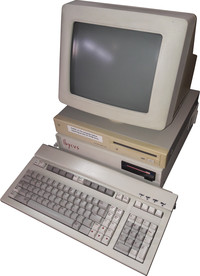Ibycus Scholarly Computer
| Home > Browse Our Collection > Computers > Ibycus > Ibycus Scholarly Computer |
|
The Ibycus Scholarly Computer is a custom-built machine developed by David W. Packard and William Johnson, who co-founded a company in 1985 and developed the first computer that allowed the editing, search, and retrieval of Classical texts in a fully integrated desktop package. It worked with the Latin, Greek, Hebrew, and Coptic alphabets. The computer use a Motorola MC68008 which ran at 8MHz. Its operating system, IBYX, The computer had a 3.5-inch disk drive built into the unit, and also came with a Sony CD-ROM drive. It was compatible with the Hewlett-Packard LaserJet and LaserJet Plus, Epson LQ 800/1000, and code-compatible 24-pin dot matrix printers such as the NEC P6. Manufacturer: Ibycus Comments for Ibycus Scholarly Computer :Ibycus Information - 13 Aug 2019
It was custom made for using the Thesaurus Linguae Graecae Data. When the Packard institute first produced this data with a huge donation from Packard himself to pay for all the man-hours, they found there was no hardware that could easily edit the stuff electronically. So they made it. The Ibycus was revolutionary in that you could type English then press a button and type Hebrew from Right to Left. It took IBM PC about a decade to catch up with this. (Actually, mixed Left-to-Right English and Right-to-Left Hebrew was first available on the Amstrad CPC computer, using software made by me. I needed it for writing my thesis, and I sold it to most of the synagogue newspapers in the UK, who all bought Amstrads because PCs weren't capable of doing this.) Very few Ibycus computers were ever made. I think there were only a handful in the UK. Comment on This Page This exhibit has a reference ID of CH54883. Please quote this reference ID in any communication with the Centre for Computing History. |
|











